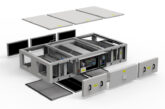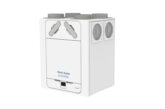
Which ventilation system is best for your client’s home or project? The technical team at Blauberg offer you some handy pointers.
There is much confusion over differing methods of ventilation and which is most suitable.
Clearly the type of property will have a large bearing on the system that you choose – an older house that has trickle vents, airbricks and chimneys can use these features to its advantage, whereas a newer, more airtight property can also play to its strengths.
Approved document F recognises four fundamental systems – three of them are electrical and one is passive – so let’s take a look at the three electrical systems:
SYSTEM 1 – INTERMITTENT FANS WITH BACKGROUND VENTILATORS
Traditional bathroom and kitchen fans (including cooker hoods) are classed as intermittent.
They’re switched on and off as required and rely on passive supply via background vents. This system favours a house that has some natural air leakage.
SYSTEM 3 – MECHANICAL EXTRACT VENTILATION WITH BACKGROUND VENTILATORS (M.E.V)
A centralised extract system which extracts from all wet rooms and exhausts via a single duct.
Again, this system relies on passive supply via background vents, but differs from intermittent by running continuously and having trickle and boost speed settings.
This system also suits a house that has some natural air leakage.
SYSTEM 4 – MECHANICAL VENTILATION WITH HEAT RECOVERY (M.V.H.R)
A centralised system which extracts from all wet rooms and has a controlled flow of supply air which is warmed, via a heat exchanger, by the extracted air.
This differs, fundamentally, from all other systems as it does not require any further background vents and favours an airtight house.
If you are interested in attending Blauberg’s two-day training course on BPEC Domestic Ventilation Systems, email: rob.holton@blauberg.co.uk or visit: https://www.blauberg.co.uk/en/heat-recovery-system-installer/.











